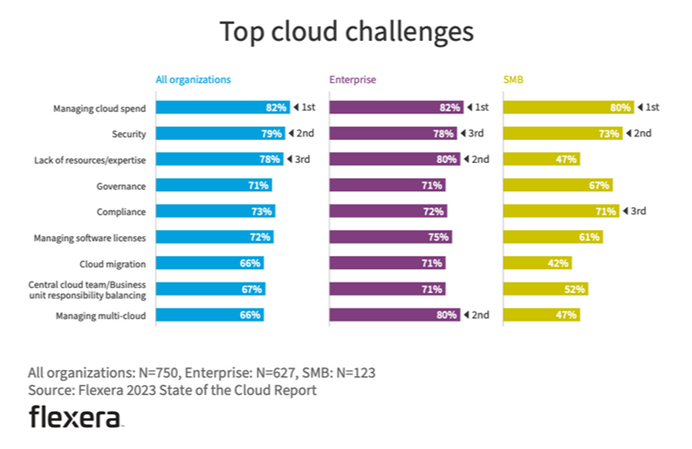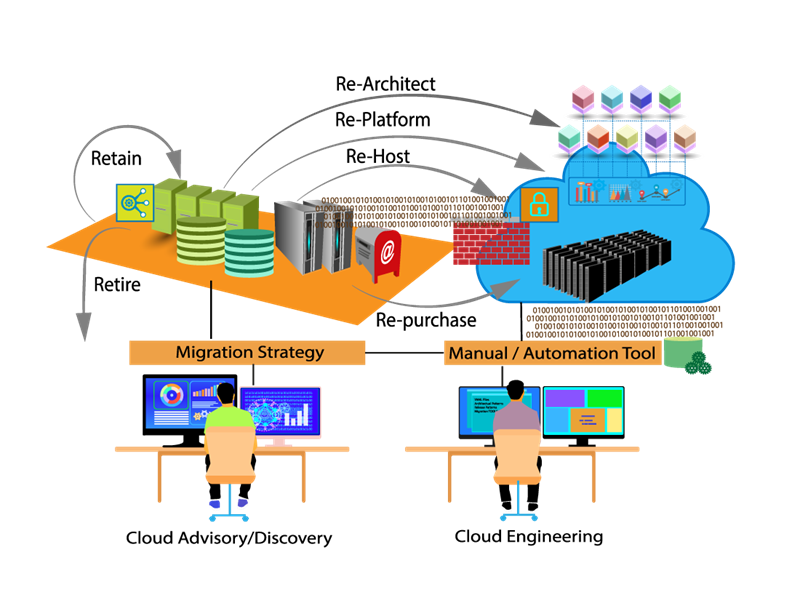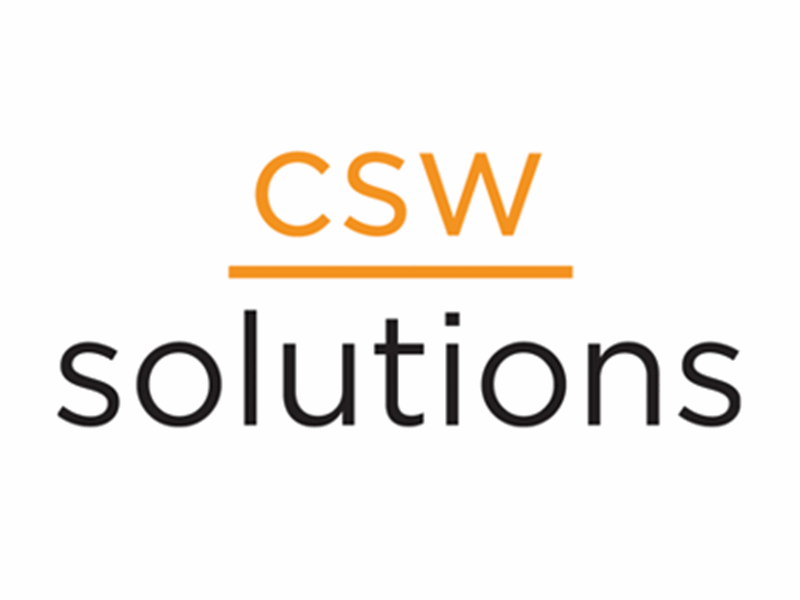Cloud migration and managed services are the best way to improve your business and operations. Read on to learn more about what CSW Solutions can do for you as your Gold-certified cloud solutions partner.
Leveraging Azure for Enhanced Cloud Efficiency
In today's rapidly evolving business landscape, harnessing the power of the cloud has become imperative for organizations aiming to stay ahead of the competition. With its expansive suite of services and unparalleled scalability, Microsoft Azure has emerged as a formidable platform for businesses seeking enhanced cloud efficiency. By leveraging Azure's cutting-edge technologies, businesses can optimize their operations, streamline processes, and unlock new opportunities for growth. In this article, we will explore how businesses can utilize Azure to drive efficiency, unlock innovation, and achieve their strategic objectives with confidence.
Recent data and reports indicate that security and expertise are crucial factors for businesses when considering cloud solutions as they look to move even more workloads to the cloud. According to a survey conducted by Flexera, 82% of respondents reported that managing cloud spend is their top challenge. Azure's ability to swiftly scale operations based on demand aligns with this trend, allowing businesses to adapt to changing market conditions and optimize resource utilization.

Moreover, the importance of business continuity and disaster recovery has become increasingly apparent in light of recent events. For instance, the COVID-19 pandemic highlighted the need for resilient and secure cloud solutions. According to a report by IBM, businesses that invested in cloud-based disaster recovery solutions experienced significantly lower downtime and faster recovery times compared to those relying on traditional infrastructure. Azure's robust backup and recovery services align with this trend and help organizations maintain uninterrupted operations even during unexpected disruptions.
By now we are all aware of artificial intelligence (AI) and live comfortably with Internet of Things (IoT) technologies. It's notable that businesses who continue to prioritize digital transformation and leverage advanced technologies have a higher likelihood of outperforming their competitors. According to a report by Forbes Advisor, over 60% of business owners believe AI will increase productivity. 64% said that AI would improve business productivity and 42% believe it will streamline operations. Azure's at the top of the game with an extensive suite of services in AI and IoT, among others, empowers organizations to embrace innovation and unleash their competitive potential in the digital age.
When comparing the benefits of leveraging Azure for enhanced cloud efficiency with the latest data and reports on cloud optimization, it is evident that these themes align with current industry trends and demands. The scalability, flexibility, business continuity, and innovation capabilities offered by Azure enable businesses to adapt, survive, and thrive in a rapidly evolving business landscape. By embracing Azure and harnessing its advanced technologies, organizations can position themselves as leaders in their respective industries and enhance their overall efficiency and competitiveness.
Azure cloud adoption typically follows a set of stages, each with its own specific goals and considerations. These stages are:
Discovery and Assessment:
When adopting cloud technology, there are several strategies that businesses can implement to minimize costs. One of the key strategies is to carefully assess and plan the cloud infrastructure needs of the business. This involves understanding the specific requirements of the organization and selecting the most appropriate cloud service providers and solutions. By ensuring that the chosen cloud services align with the business needs, unnecessary costs can be avoided. This stage involves understanding the organization's current infrastructure and identifying potential areas where Azure can provide value. It includes analyzing workloads, assessing security requirements, and evaluating existing applications and systems. It is so important to conduct a thorough assessment of the organization's current IT infrastructure and identify the specific needs and requirements for the cloud solutions they will rely on. This will help in selecting the most suitable cloud provider and service model, thus avoiding unnecessary expenses.
Planning and Design:
In this stage, organizations develop a comprehensive plan for migrating to Azure. This includes defining the target architecture, identifying Azure migration strategies, and establishing governance and security policies. It also involves determining the necessary resources and skills required for a successful migration. Additionally, businesses can consider using a mix of cloud service models in this stage, such as Infrastructure-as-a-Service (IaaS), Platform-as-a-Service (PaaS), and Software-as-a-Service (SaaS). By leveraging the most appropriate service models for different aspects of the business, organizations can optimize costs while still meeting their operational requirements.
Defining the target architecture is an essential step in the migration process. This involves determining the desired state of the organization's IT infrastructure once the migration to Azure is complete. It includes considerations such as the types of Azure services to be used, the network architecture, and the overall design of the environment. By defining the target architecture, organizations can have a clear vision of their end goals and ensure that their migration efforts align with those goals.
Identifying migration strategies mean businesses will diligently consider the different migration methods to use depending on their specific needs and requirements. These methods can include lift-and-shift migrations, where applications are moved as-is to Azure, or more complex approaches such as re-architecting or re-platforming applications to take advantage of Azure's native services. By carefully considering these strategies, organizations can minimize disruptions and achieve a successful migration.
Establishing governance and security policies is also a vital part of the planning process. When migrating to Azure, organizations must ensure that they have robust policies in place to govern the use of resources and maintain security. This includes defining roles and responsibilities, implementing access controls, and setting up monitoring and auditing mechanisms. By establishing these policies from the outset, organizations can ensure that their migration to Azure is secure and compliant with industry standards and regulations.
Proof of Concept:
This stage involves conducting a small-scale pilot to validate the planned migration approach. When organizations are planning a migration approach, conducting a proof of concept is an essential step to validate the planned strategy. This involves conducting a small-scale pilot to ensure that the migration approach will work effectively and meet the organization's objectives. By testing the migration process on a smaller scale, any potential issues or challenges can be identified and addressed before implementing the migration on a larger scale.
During the proof of concept, organizations should carefully consider their storage and computing needs. This includes assessing the amount of data that needs to be migrated, the storage capacity required, and the computing power needed to support the migration process. It is important to accurately estimate the required amount of storage and computing resources, organizations can avoid over-provisioning and paying for unused capacity. Additionally, utilizing cloud storage solutions instead of local servers can help reduce hardware and maintenance costs. It allows businesses to explore Azure capabilities, evaluate performance, and address any technical or operational challenges. The goal is to gain confidence in the migration strategy before proceeding to full-scale implementation.

Migration:
The migration stage involves moving workloads, data, and applications from on-premises or other cloud environments to Azure. It can be executed in phases or as a big-bang approach, depending on the organization's requirements and complexity. Migration tools and services provided by Azure can help simplify and automate the process. Another cost-saving strategy is to prioritize and optimize workload placement.
Consider reserved instances and spot instances: Reserved instances allow you to commit to a specific workload capacity for a longer duration, often at a discounted price. Spot instances, on the other hand, are unused computing resources offered at significantly lower prices.
By leveraging these options, you can further reduce costs. By analyzing the performance and resource requirements of different workloads, organizations can determine the most cost-effective cloud deployment options. For example, workloads with high computational demands may benefit from using spot instances or reserved instances, which offer lower costs compared to on-demand instances.
Optimization and Management:
After the migration is complete, organizations focus on optimizing their Azure environment for performance, cost-efficiency, and security. This includes rightsizing resources, implementing monitoring and management tools, and establishing governance frameworks. Organizations should also regularly review and optimize their cloud usage.
Rightsizing resources involves analyzing the usage and performance of virtual machines and other resources to ensure that they are appropriately sized for the workload. By ensuring that resources are not over-provisioned or underutilized, organizations can optimize performance and minimize costs.
Implementing monitoring and management tools is also crucial. Azure provides a range of tools for monitoring resource utilization, identifying performance bottlenecks, and managing costs. By regularly monitoring and analyzing data, organizations can identify areas for improvement and take proactive measures to optimize their environment.
Establishing governance frameworks is another important step. This involves defining policies and procedures for resource allocation, security configurations, and cost management. By implementing governance frameworks, organizations can ensure that resources are used in a controlled and efficient manner, while also maintaining compliance with security and regulatory requirements.
Regular review is also essential. The technology landscape is constantly evolving, and it is important to regularly review and update Azure configurations and settings to ensure optimal performance, cost-efficiency, and security. This includes staying up to date with new features and best practices, as well as regularly assessing and adjusting resource allocations based on changing workload requirements.
By continuously optimizing cloud usage, organizations can ensure they are getting the most value for their investment. Ongoing management tasks such as backup, disaster recovery, and scaling are also addressed in this stage.
Innovation and Automation:
Once the Azure environment is stable and optimized, organizations can leverage the platform's capabilities to drive innovation and minimize redundancies by implementing automation. This stage involves exploring advanced services like automation and resource management tools that can help in reducing costs along with AI, machine learning (ML), IoT, and analytics. These are all powerful tools that can be utilized to gain new insights and enhance business processes. By harnessing the capabilities of these technologies, businesses can improve efficiency, make more informed decisions, and ultimately drive growth.
AI and ML algorithms can analyze vast amounts of data and identify patterns and trends that humans may not be able to detect. This can help businesses optimize their operations, streamline processes, and make predictive forecasts. For example, AI-powered chatbots can handle customer inquiries and provide personalized recommendations, improving customer satisfaction and reducing the workload on human employees.
The IoT allows businesses to connect and collect data from various devices and sensors, providing real-time information about their operations. This data can be analyzed using AI and machine learning techniques to identify areas for improvement and enhance decision-making. For instance, in manufacturing, IoT devices can monitor equipment performance and automatically schedule maintenance to prevent breakdowns and optimize production.
Analytics involves the use of statistical and quantitative analysis techniques to gain insights from data. By analyzing data collected from AI, ML, and IoT devices, businesses can uncover patterns, trends, and anomalies that can inform decision-making. Resource management tools can monitor and analyze resource utilization to identify areas for optimization and cost reduction. For example, analyzing customer data can help businesses understand their preferences and tailor their products or services accordingly.
Automation can optimize resource allocation, scale resources based on demand, and schedule non-critical workloads during off-peak hours to take advantage of lower pricing options. There are several ways in which organizations can leverage automation in Azure. For example, they can use Azure Automation to create runbooks that automate complex workflows and processes. These runbooks can be triggered by specific events or scheduled to run at regular intervals.
Additionally, organizations can take advantage of Azure Logic Apps, which provide a visual interface for designing and orchestrating workflows across various services and systems. Logic Apps allow for the integration of different applications and data sources, enabling seamless automation of business processes.
Furthermore, Azure Functions provide serverless computing capabilities, allowing organizations to execute code in response to events or triggers without the need to provision or manage infrastructure. This enables organizations to build highly scalable and event-driven applications that can respond to changes in real-time.
Governance and Compliance:
Throughout the entire cloud adoption journey, organizations need to establish robust governance and compliance frameworks to ensure data security, privacy, and regulatory compliance. This involves defining policies, implementing access controls, and regularly auditing and monitoring the Azure environment.
Data security is one of the key aspects of governance and compliance in cloud adoption. Organizations need to have measures in place to protect their data from unauthorized access, breaches, and cyber threats. This involves implementing strong authentication protocols, encryption, and access controls. Regular monitoring and auditing of the cloud environment are also essential to identify and address any potential security vulnerabilities.
Privacy is another important consideration in cloud adoption. Organizations must ensure that their data is handled in accordance with applicable privacy laws and regulations. This involves understanding where data is stored, who has access to it, and how it is used. Clear policies and procedures should be established to protect individuals' privacy rights and ensure compliance with privacy regulations.
Regulatory compliance is a critical aspect of governance in cloud adoption. Organizations need to be aware of the specific regulations that apply to their industry or geographic location and ensure that their cloud environment meets these requirements. This may include compliance with data protection laws, industry-specific regulations, or international data transfer regulations. Regular audits and assessments can help organizations demonstrate their compliance and address any non-compliance issues promptly.
Establishing a robust governance and compliance framework requires collaboration between different stakeholders within an organization, including IT, legal, and compliance teams. It requires a proactive approach to identify risks, develop policies and procedures, and implement controls to mitigate those risks. Regular training and communication are also important to ensure that employees understand their roles and responsibilities in maintaining governance and compliance in the cloud environment.
It's important to note that the stages mentioned above are not strictly sequential, and businesses may revisit and iterate on previous stages as their needs and strategies evolve with their partners or managed service providers. Azure cloud adoption is a continuous process that requires ongoing planning, optimization, and innovation to fully leverage the benefits of the platform.
Collaboration:
Collaborating with specialized Azure partners and managed service providers (MSP) is crucial for cost optimization and efficiency in the cloud. These professionals have the expertise and experience to help businesses maximize their investment in Azure and achieve cost savings.
One of the main reasons why collaboration is so important is because cloud solutions like Azure are complex platforms with a growing library of different services and features that are beneficial to industry-specific goals and operations. It can be challenging for businesses to navigate and understand all of the options available to them. By working with specialized Azure partners or MSP, businesses can access their deep knowledge of the platform and receive guidance on which services and features are most suitable for their specific needs. This ensures that businesses are only paying for what they actually need, thereby optimizing costs.
Furthermore, these partners and providers have access to tools and technologies that can help monitor and analyze cloud usage. They can identify areas of inefficiency or waste, such as underutilized resources or unnecessary storage, and provide recommendations for improvement. By addressing these inefficiencies, businesses can reduce their cloud costs and improve overall efficiency.
Collaboration also allows businesses to benefit from ongoing support and maintenance. Azure partners and MSPs can assist with troubleshooting, performance optimization, and security management. They can proactively monitor the cloud environment and address any issues or vulnerabilities. This proactive approach helps businesses avoid costly downtime or security breaches, further enhancing cost optimization.
Conclusion
In conclusion, leveraging Azure for enhanced cloud efficiency offers numerous benefits for businesses across different industries. Whether you're looking to improve cloud spend, increase security, or manage software licenses, there is a comprehensive solution for all of it. By utilizing Azure's wide range of services and tools and collaborating with the right team, businesses can streamline their operations, reduce costs, and gain a competitive edge in the market.
It is clear that each stage of the Azure implementation process is crucial to the success of your current and future business endeavors. From initial planning and assessment to migration and ongoing management, it is imperative to have a strategic approach and experienced guidance throughout the entire journey. CSW Solutions is a trusted partner that specializes in Azure solutions and can provide the expertise needed to ensure a seamless and successful implementation.
Don't miss out on the benefits that Azure can bring to your business. Reach out to CSW Solutions today to collaborate on leveraging Azure for enhanced cloud efficiency. With their knowledge and experience, they can help you maximize the potential of Azure and drive your business forward.
